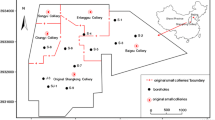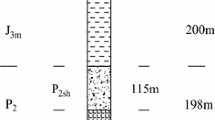Abstract
Ground water inrush from underlying coal seam aquifers is a serious geohazard during coal mining in China. In order to effectively predict coal floor water inrush, the evaluation index system and evaluation standard for coal floor water inrush, containing quantitative indexes and qualitative indexes, is established on the base of conditions of aquifer and aquiclude, geologic structure and mining disturbance. Simultaneously, grey relational analysis and analytic hierarchy process are used to establish an evaluation model which efficiently overcomes the uncertainty between indexes of water inrush effects and really reflects the degree of importance for each index of water inrush effects. The model is applied to the typical working face of Yuzhou coalfield in the north of China to demonstrate the evaluation process. Compared to the water inrush coefficient method which is widely used for evaluating coal floor water inrush, the presented evaluation model in this paper accords more with the susceptibility of coal floor water inrush by multi-factor and is of nonlinear dynamic characteristics of highly complicated formation mechanism. This method offers a new tool in the assessment of ground water inrush in mine.



Similar content being viewed by others
References
Bense VF, Van D, Berg EH (2003) Deformation mechanisms and hydraulic properties of fault zones in unconsolidated sediments. Hydrogeol J 11(3):319–332
Bieniawski ZT (1967) Mechanism of brittle fracture of rock. Part2. Experimental studies. Int J Rock Mech Min Sci 14(1):407–423
Deng JL (1985) The relational space in grey system theory. Fuzzy Math 2:1–10
Deng JL (1989) Introduction to grey system. J Grey Syst 1(1):1–24
Guan ET (2012) Origin of water bursting coefficient and process of modification. Coal Geol China 24(2):30–32
Jin DW (2000) Review on study of Pan-decision analysis theory of water inrush forecast through coal bottom layer in mining working face. J Jiaozuo Inst Technol (Nat Sci) 19(4):246–248
Li BY (1999) “Down Three Zones” in the prediction of the water inrush from coalbed floor aquifer-theory, development and application. J Shandong Inst Min Technol (Nat Sci) 18(4):11–18
Liu Q (2009) A discussion on water inrush coefficient. Coal Geol Explor 37(4):34–38
Men HL, Yang JW, Liu CA (2012) Floor water irruption prediction of mining face above confined water. Saf Coal Mines 43(11):174–177
Qian MG, Miao XX, Xu JL (1996) Theoretical study of key stratum in ground control. J China Coal Soc 21(3):225–230
Saaty TL (1980) The analytic hierarchy process. McGraw-Hill, New York
Saaty TL (2000) Fundamentals of decision making and priority theory. RWS Publications, Pittsburgh
Santos CF, Bieniawski ZT (1967) Floor design in underground coalmines. Rock Mech Rock Eng 22(4):249–271
Sato T, Kikuchi T, Sugihara K (2000) In-situ experiments on an excavation disturbed zone induced by mechanical excavation in Neogene sedimentary rock at Tone mine, central Japan. Eng Geol 56(1–2):97–108
Shi LQ (2009) Summary of research on mechanism of water inrush from seam floor. J Shandong Univ Sci Technol 28(3):17–23
Shi LQ (2012) Analysis of the origin of water inrush coefficient and its applicability. J Shandong Univ Sci Technol 31(6):6–9
Shi HX, Liu SF, Fang ZG (2008) The model of grey periodic incidence and their rehabilitation. Chin J Manag Sci 16(3):131–136
Wang CX, Wang HM (2004) Thinking about theories and practices on mine water control. Coal Geol Explor 32(11):100–103
Wu Q, Yang L, Zhu B (2009) Application of vulnerability index method in coal floor water bursting evaluation in Zhaogezhuang coalmine. Coal Geol China 21(6):40–44
Yang TH, Tang CA, Tan ZH (2007) State of the art of inrush models in rock mass failure and developing trend for prediction and forecast of groundwater inrush. Chin J Rock Mech Eng 26(2):269–275
Zhang JC, Liu TQ, Liu CA (1990) On depth of fissured zone in seam floor resulted from coal extraction and its distribution characteristics. J China Coal Soc 15(2):46–54
Zhang FD, Meng XR, Gao ZN (2013) Study on mechanism of floor water inrush induced by water rise along fractures. Min Saf Environ Prot 40(2):41–44
Acknowledgments
This research was financially supported by China National Natural Science Foundation (Grant Nos. 41430318, 41272276), the China National Scientific and Technical Support Program (Grant Numbers 201105060-06, 2012BAB12B03), Guizhou Province Science and Technology Agency Foundation (qian ke he LH zi[2014]7617), Guizhou University Introducing Talents Research Foundation (2014-61).
Author information
Authors and Affiliations
Corresponding author
Rights and permissions
About this article
Cite this article
Li, B., Chen, Y. Risk Assessment of Coal Floor Water Inrush from Underlying Aquifers Based on GRA–AHP and Its Application. Geotech Geol Eng 34, 143–154 (2016). https://doi.org/10.1007/s10706-015-9935-z
Received:
Accepted:
Published:
Issue Date:
DOI: https://doi.org/10.1007/s10706-015-9935-z




